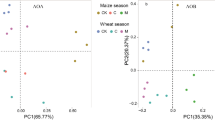Abstract
Soil heavy metal pollution has received increasing attention due to their toxicity to soil microorganisms. We have analyzed the effects of heavy metal pollution on ammonia-oxidizing archaea (AOA) and ammonia-oxidizing bacteria (AOB) in soils in the vicinity of a tailings dam of Baotou region, China. Results showed that AOB were dominated with Nitrosomonas-like clusters, while AOA was dominated by group1.1b (Nitrososphaera cluster). Single Cd and Cr contents, as well as compound heavy metal pollution levels, had a significant negative impact on soil potential nitrification rate and both diversities of AOA and AOB. No clear relationship was found between any single heavy metal and abundance of AOA or AOB. But compound pollution could significantly decrease AOA abundance. The results indicated that heavy metal pollution had an obviously deleterious effect on the abundance, diversity, activity and composition of ammonia oxidizers in natural soils.



Similar content being viewed by others
References
Bollmann A, Laanbroek HJ (2001) Continuous culture enrichments of ammonia-oxidizing bacteria at low ammonium concentrations. FEMS Microbiol Ecol 37:211–221
Chand V, Prasad S (2013) ICP-OES assessment of heavy metal contamination in tropical marine sediments: A comparative study of two digestion techniques. Microchem J 111(14):53–61
Chen JL, Xie WX, Cui YQ, Zhang Y (2016) Research on the determination of total nitrogen and total phosphorus in soil using SmartChem140 automatic chemical analyzer. J Anal Sci 32(1):84–88. (In Chinese)
Francis CA, Roberts KJ, Beman JM, Santoro AE, Oakley BB (2005) Ubiquity and diversity of ammonia-oxidizing archaea in water columns and sediments of the ocean. P Natl Acad Sci USA 102:14683–14688
Huang X, Deng H, Zheng C, Cao G (2016) Hydrogeochemical signatures and evolution of groundwater impacted by the Bayan Obo tailing pond in northwest China. Sci Total Environ 543:357–372
Jia T, Cao MW, Jing JH, Liu JX, Chai BF (2017) Endophytic fungi and soil microbial community characteristics over different years of phytoremediation in a copper tailings dam of Shanxi, China. Sci Total Environ 574:881–888
Kurola J, SalkinojaSlonen M, Aarnio T, Hultman J, Romantschuk M (2005) Activity, diversity and population size of ammoniaoxidising bacteria in oil-contaminated landfarming soil. Fems Microbiol Lett 250:33–38
Li XF, Zhu YG, Cavagnaro TR, Chen MM, Sun JW, Chen XP et al (2009) Do ammonia-oxidizing archaea respond to soil Cu contamination similarly as ammonia- oxidizing bacteria? Plant Soil 324:209–217
Mertens J, Broos K, Wakelin SA, Kowalchuk GA, Springael D, Smolders E (2009) Bacteria, not archaea, restore nitrification in a zinc-contaminated soil. ISME J 3(8):916–923
Nejidat A (2005) Nitrification and occurrence of salt-tolerant nitrifying bacteria in the Negev desert soils. Fems Microbiol Ecol 52:21–29
Ollivier J, Wanat N, Austruy A, Hitmi A, Joussein E, Welzl G et al (2012) Abundance and diversity of ammonia-oxidizing prokaryotes in the root-rhizosphere complex of miscanthus × giganteus grown in heavy metal-contaminated soils. Microb Ecol 64(4):1038–1046
Park S, Ely RL (2008) Candidate stress genes of Nitrosomonas europaea for monitoring inhibition of nitrification by heavy metals. Appl Environ Microb 74(17):5475–5482
Rotthauwe J, Witzel K, Liesack W (1997) The ammonia monooxygenase structural gene amoA as a functional marker: molecular fine-scale analysis of natural ammonia-oxidizing populations. Appl Environ Microbiol 63:4704–4712
Shen JP, Zhang LM, Zhu YG, Zhang JB, He JZ (2008) Abundance and composition of ammonia-oxidizing bacteria and ammonia-oxidizing archaea communities of an alkaline sandy loam. Environ Microbiol 10(6):1601–1611
Si WT, Liu JM, Cai L, Jiang HM, Zheng CL, He XY et al (2015) Health risks of heavy metals in contaminated farmland soils and spring wheat irrigated with Yellow River water in Baotou, China. Bull Environ Contam Tox 94(2):214–219
Si WT, He XY, Li AL, Liu L, Li JS, Gong DH et al (2016) Application of an integrated biomarker response index to assess ground water contamination in the vicinity of a rare earth mine tailings site. Environ Sci Pollut Res 23(17):1–12
Smolders E, Brans K, Coppens F, Merckx R (2001) Potential nitrification rate as a tool for screening toxicity in metal contaminated soils. Environ Toxicol Chem 20:2469–2474
Spang A, Poehlein A, Offre P, Zumbrägel S, Haider S, Rychlik N et al (2012) The genome of the ammonia oxidizing Candidatus Nitrososphaera gargensis: insights into metabolic versatility and environmental adaptations. Environ Microbiol 14:3122–3145
Subrahmanyam G, Hua HW, Zheng YM, Archana G, He JZ, Liu YR (2014a) Response of ammonia oxidizing microbes to the stresses of arsenic and copper in two acidic alfisols. Appl Soil Ecol 77:59–67
Subrahmanyam G, Shen JP, Liu YR, Archana G, He JZ (2014b) Response of ammonia-oxidizing archaea and bacteria to long-term industrial effluent-polluted soils, Gujarat, Western India. Environ Monit Assess 186:4037–4050
Vasileiadis S, Coppolecchia D, Puglisi E, Balloi A, Mapelli F, Hamon RE et al (2012) Response of ammonia oxidizing bacteria and archaea to acute zinc stress and different moisture regimes in soil. Microb Ecol 64(4):1028–1037
Zhou ZF, Liu YR, Sun GX, Zheng YM (2015) Response of soil ammonia oxidizers to a short-term severe mercury stress. J Environ Sci 38:8–13
Acknowledgements
The project was supported by the National Natural Science Foundation of China (Nos. 31460142, 31560015).
Author information
Authors and Affiliations
Corresponding authors
Rights and permissions
About this article
Cite this article
Liu, J., Cao, W., Jiang, H. et al. Impact of Heavy Metal Pollution on Ammonia Oxidizers in Soils in the Vicinity of a Tailings Dam, Baotou, China. Bull Environ Contam Toxicol 101, 110–116 (2018). https://doi.org/10.1007/s00128-018-2345-1
Received:
Accepted:
Published:
Issue Date:
DOI: https://doi.org/10.1007/s00128-018-2345-1




